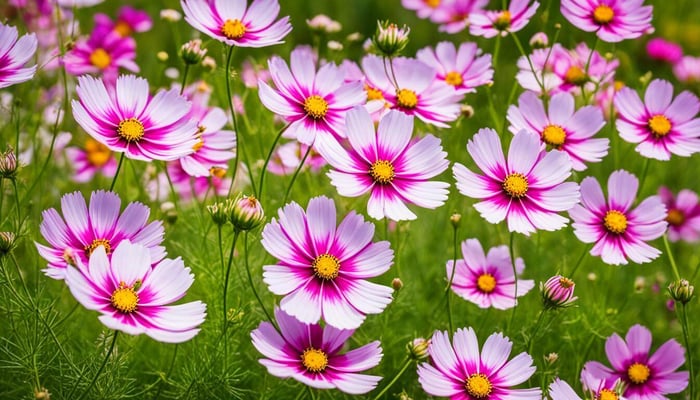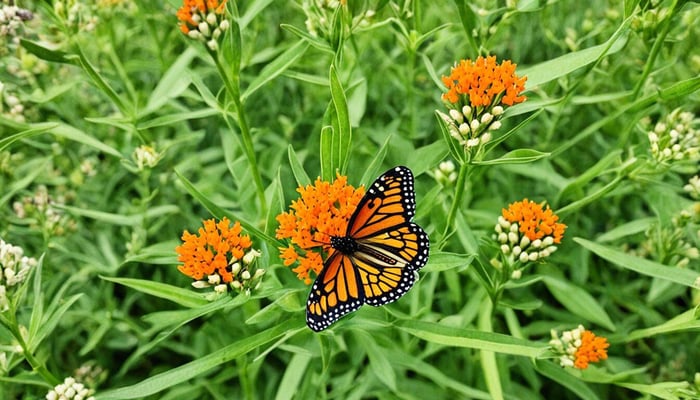Did you know that monarch butterflies experience a staggering migratory journey of up to 3,000 miles, relying on specific flora like the showy milkweed and Asclepias speciosa to sustain their lifecycle? This incredible fact sheds light on our critical role in providing these majestic creatures with habitats that support their survival. As gardeners, we have the power to make a significant difference by growing milkweed, offering a lifeline in the form of nectar-rich flowers and essential breeding grounds. Starting seeds indoors gives us a head start, ensuring a higher germination rate and a strong, full, sun-loving milkweed presence in our gardens. Learning how to grow showy milkweed from seed isn't just beautiful for your garden but also saves the butterflies.
Embracing the splendor and purpose of the showy milkweed doesn’t just create a burst of color and beauty in our outdoor spaces; it contributes to the continuity of the monarch butterflies' awe-inspiring journey. By learning the techniques for high germination rate of flower seeds and successful nurturing of these milkweed plants, we can turn our gardens into vital waystations for these winged wonders. Our commitment to growing milkweed, particularly Asclepias speciosa, is an act of eco-conscious gardening that supports the broader web of life right from our backyards.
Key Takeaways
- During their lengthy migration, monarch butterflies depend on milkweed plants like Asclepias speciosa for feeding and breeding.
- Starting milkweed seeds indoors can lead to robust, showy growth due to a high germination rate.
- Planting showy milkweed supports the conservation and survival of monarch butterflies by providing essential habitat.
- Asclepias speciosa thrives in full sun and is an attractive addition to any butterfly garden.
- Understanding milkweed seed germination and cultivation processes is vital for attracting and sustaining monarch populations.
- Proactive gardening choices, like growing showy milkweed, positively impact the local ecosystem and biodiversity.
Showy Milkweed Seeds
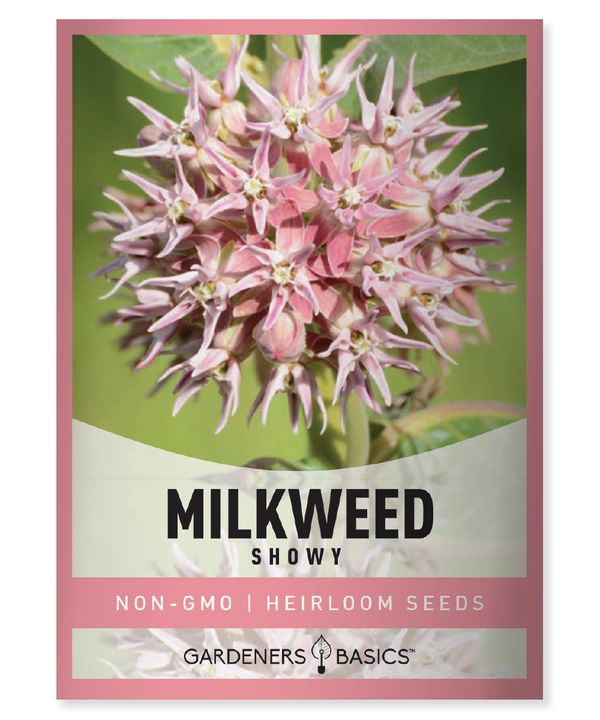
$2.49
Showy Milkweed Seeds – Heirloom, Non-GMO, Non-Hybrid, Open-Pollinated Transform your garden into a pollinator’s paradise with our Showy Milkweed seeds! These premium heirloom seeds are non-GMO, non-hybrid, and open-pollinated, making them ideal for gardeners seeking reliable, natural growth. Perfect for… read more
Showy Milkweed Seed Basics
- Days till maturity: Showy milkweed typically takes about 90 to 100 days to reach maturity after germination. This period is crucial for developing the plant's characteristic flowers and becoming established enough to survive in its environment.
- Planting depth: The showy milkweed seeds should be sown about 1/4 inch deep in the soil. This shallow planting depth helps ensure that the seeds have adequate contact with the soil while being exposed to enough light and oxygen to germinate effectively.
- Plant spacing: Space showy milkweed plants about 18 to 24 inches apart for optimal growth. This spacing allows each plant enough room to grow and spread without competing too much with each other for resources.
- Days to germination: Showy milkweed seeds typically germinate within 10 to 20 days after sowing, assuming conditions are optimal with warm temperatures and moist soil. It's important to keep the soil consistently moist during the germination period.
- Indoors or Direct Sown: Showy milkweed seeds can be started indoors about 8 to 10 weeks before the last frost date or sown directly outdoors after the danger of frost has passed. Starting seeds indoors can give them a head start, especially in cooler climates.
- Full Sun or Partial Shade: Showy milkweed thrives best in full sun but can tolerate partial shade. However, plants grown in full sun tend to be more robust and produce more flowers.
- When to harvest: Generally, showy milkweed is not harvested but allowed to grow and spread. If collecting seeds, wait until the pods mature and begin to open, typically in late summer or early fall.
- How tall does the plant get?: Showy milkweed can grow about 2 to 4 feet tall, depending on the growing conditions and the plant's genetic disposition.
- How wide does the plant get?: The plant can spread about 2 to 3 feet wide, with its sprawling growth habit and the ability to send out runners that can start new plants nearby.
- Native: Showy milkweed is native to much of the United States and Canada, particularly in areas with temperate climates. It is an important plant for many ecosystems, providing food and habitat for wildlife, including monarch butterflies.
- Family: Showy milkweed belongs to the Asclepiadaceae (milkweed) family. This family is known for its milky sap, complex flower structure, and importance as a host plant for monarch butterflies.
Understanding the Importance of Showy Milkweed
As conscientious stewards of the environment, we recognize the critical role milkweed Asclepias play in maintaining the delicate balance of our ecosystem. Especially for the remarkable monarch butterflies, the presence of milkweed is non-negotiable — it's the core fabric of their existence, supporting them from larva to soaring adulthood.
The Role of Milkweed in Monarch Butterfly Life Cycle
Milkweed plants are not just another flowering perennial; they are the exclusive host for monarch caterpillars. The monarch's life cycle begins when eggs are laid on the underside of milkweed leaves. Once hatched, the larvae feed on these leaves, ingesting protective toxins that deter predators. Without common milkweed and its relatives, the monarchs' lifecycle would be disrupted, possibly leading to their decline. Our milkweed gardens thus become sanctuaries for these fluttering jewels.
Why Choose Showy Milkweed: Asclepias Speciosa
Among the various types of milkweed, Asclepias speciosa, commonly known as showy milkweed, stands out. It is a magnificent sight and an excellent nutrient source for monarch caterpillars. When asking ourselves why we select Asclepias speciosa over other varieties like Asclepias tuberosa, consider this — its ample foliage and large flower clusters make showy milkweed a veritable monarch magnet, thus playing a pivotal role in butterfly conservation.
| Criteria | Common Milkweed (Asclepias Syriaca) | Showy Milkweed (Asclepias Speciosa) |
|---|---|---|
| Appearance | Pinkish-purple clusters | Pink to rose-purple flowers in large clusters |
| Preferred by Monarchs | Yes, for egg-laying and larval food source | Highly preferred for its ample foliage and flower clusters |
| Plant Robustness | Highly robust and can spread rapidly | Robust with controlled spread, suitable for garden cultivation |
| Soil Tolerance | Adaptable, thrives in various soil types | Prefer well-drained soils but adaptable to various conditions |
In essence, when we plant Asclepias speciosa, we are not just growing a garden; we are curating a habitat. By choosing showy milkweed, we provide for our local monarch populations and create a vibrant, life-affirming sanctuary in our backyards. As gardeners, the decision to grow Asclepias speciosa is a conscious step toward ecological preservation, and it's a choice that the majestic monarch butterflies depend on for their survival and prosperity.
Choosing the Right Milkweed Seed Variety
As we dive into the selection process for the ideal milkweed seed, we recognize that certain varieties bode better for attracting and sustaining the delicate populations of monarch butterflies. Our initiative is straightforward – integrate milkweed varieties that flourish in our gardens and produce the highest germination rate to maximize our conservation efforts.
Choosing the appropriate seed variety can be a delightfully daunting task with the vast array of species within the Asclepias genus. Nevertheless, Gardeners Basics simplifies this process by offering an array of milkweed seed types known for their garden vibrancy and role as beacons for migratory monarch butterflies. A fine example of a highly favored variety by both gardeners and monarchs alike is the Asclepias speciosa, also known as the showy milkweed, which possesses all the desirable traits one would seek in a milkweed plant.
| Variety | Description | Germination Rate | Monarch Attraction Level |
|---|---|---|---|
| Asclepias speciosa (Showy Milkweed) | Luxuriant flower clusters, ideal for temperate regions | High | Very High |
| Asclepias tuberosa (Butterfly Weed) | Bright orange flowers, drought-resistant | Moderate to High | High |
| Asclepias incarnata (Swamp Milkweed) | Pink blooms, tolerates moist conditions | Moderate | High |
We must be discerning gardeners when sowing these life-sustaining seeds. Prioritizing seeds with a high germination rate ensures that our green efforts come to fruition, establishing a thriving garden space. Let's sow the seeds of sustainability, create vibrant sanctuaries for our winged friends, and reinforce the milkweed and monarch symbiosis.
Milkweed Seeds For Monarch Butterflies | 4 Variety Pack
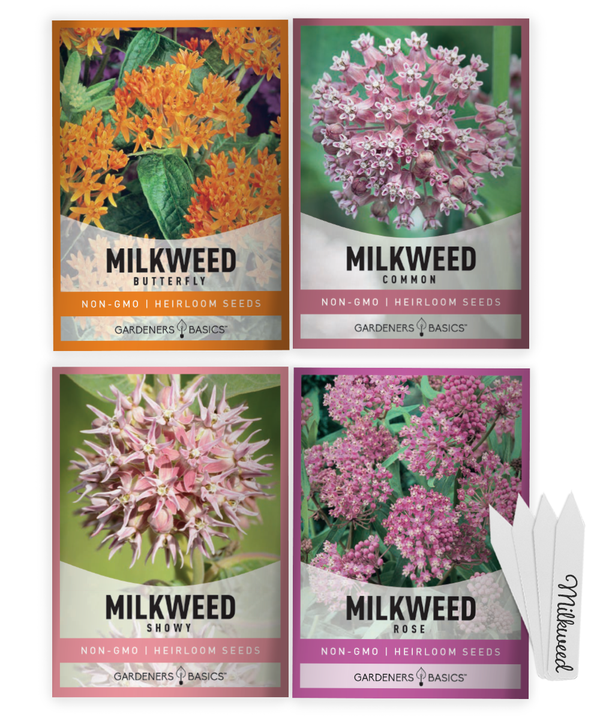
$9.95
Milkweed Seed Assortment For Planting – 4 Stunning Varieties to Attract Monarch Butterflies and Beautify Your Garden Transform your garden into a thriving paradise with our Milkweed Seed Assortment for Planting. This exclusive collection features four exquisite Milkweed varieties -… read more
Pre-Germination Tips: Increasing Your Success Rate
For those of us passionate about gardening and the conservation of monarch butterflies, starting seeds indoors is a vital step in establishing a thriving milkweed population. To increase the germination rate of these precious seeds, pre-germination techniques such as stratifying seeds and soaking milkweed seeds are essential, and here's why.
Stratifying Seeds to Mimic Natural Conditions
Stratification treats seeds to simulate the natural environmental conditions they would endure before germination. Typically, stratifying seeds involves a period of cold treatment, which breaks the seed's dormancy, a necessary step, especially for milkweed species native to temperate zones. By mimicking winter conditions, we can effectively coax these seeds into sprouting come planting time.
Soaking Milkweed Seeds to Improve Germination
The toughness of milkweed seed coats impedes water absorption, which is crucial for germination. Pre-soaking seeds for 12 to 24 hours before planting can soften these resistant exteriors. This is particularly true for soaking milkweed seeds, which benefit from this prep step to swell with moisture, thereby enhancing germination success.
By taking the time to implement these pre-germination techniques, we are setting the stage for a lush milkweed garden. These methods increase the likelihood of germination and lead to healthier, more vigorous plants capable of supporting monarch butterflies throughout their lifecycle. After all, our efforts in starting seeds indoors today can bloom into the environmental stewardship of tomorrow.
Planting Milkweed Seeds Indoors: A Step-by-Step Guide
As we embark on the journey of growing milkweed, starting seeds indoors grants us a head start in nurturing these sustainable sanctuaries for monarch butterflies. Let's dive into a well-organized, step-by-step guide that will shepherd our milkweed seed into blossoming plants ready for the full sun of our gardens.
The first phase involves selecting the appropriate soil mixture. Opt for a seed-starting mix that provides ample drainage and is lightweight enough to encourage sprouting. To begin:
- Fill clean containers with the seed-starting mix, leaving about a quarter-inch from the top.
- Press the soil to create a level surface without compacting it too much.
Next, it's time to plant the milkweed seeds. You'll want to:
- Place the milkweed seed onto the soil's surface and lightly press them in.
- Cover the seeds with a thin layer of soil, just enough to shield them from light, facilitating better germination rates.
After seeding, the soil must remain moist but not waterlogged. A spray bottle can gently mist the surface without disturbing the seeds. Seal the containers with a plastic cover to create a greenhouse effect, encouraging moisture retention and warmth.
Proper light and warmth are crucial for germination:
- Place the seeded containers in a location that maintains a steady temperature of 70 to 75 degrees Fahrenheit.
- Ensure that, after germination, seedlings receive plenty of light by placing them near a south-facing window or under grow lights to prevent legginess.
Germination could take anywhere from 10 to 30 days. Once seedlings emerge, continue to monitor soil moisture and remove the plastic cover to allow airflow and reduce the risk of mold.
When the seedlings have several true leaves, they are ready for the next phase in their growth, which is hardening off to prepare for transplanting into the full sun outdoors. But remember, patience is the companion of gardening, and slow, attentive care now means a lusher milkweed patch later on, ready to host monarch butterflies.
| Step | Action | Tips |
|---|---|---|
| 1. Soil Preparation | Fill containers with seed-starting mix. | Ensure good drainage to prevent waterlogging. |
| 2. Seeding | Plant seeds and cover with a layer of soil. | A light layer of soil promotes better germination. |
| 3. Moistening Soil | Mist with a spray bottle, then cover with plastic. | Maintain moisture for successful germination without overwatering. |
| 4. Ensuring Light and Warmth | Place in a warm area with access to light. | Keep at 70-75 degrees Fahrenheit with abundant light post-germination. |
| 5. Care Post-Germination | Monitor soil moisture and remove cover when seedlings appear. | Adequate ventilation reduces mold risk. |
With the completion of these thoughtful indoor preparations, we're well on our way to establishing a thriving haven for pollinators. Initiating the growth of milkweed seed in controlled conditions ensures that our efforts to contribute to a sustainable environment commence with strength. Doing these small steps indoors today will soon lead to brilliant displays of milkweed basking in the full sun, a testament to our dedication to beauty and biodiversity.
Transplanting Milkweed Seedlings: Timing and Techniques
As avid gardeners dedicated to nurturing milkweed plants for the benefit of the monarch butterfly, we acknowledge the delicacy required in transplanting milkweed seedlings. The transition from the sheltered indoors to the bold outdoors symbolizes a significant phase in the life of these plants. It is a transition that is as delicate as necessary, setting the stage for them to flourish under the nurturing rays of full sun.
Hardening Off Young Plants Before Outdoor Planting
Before our cherished seedlings can enjoy the freedom of the open garden, they must be gradually acclimated through a process known as hardening off. This methodical approach takes our young plants through outdoor excursions, exposing them incrementally to the elements they will soon face permanently. Through this critical phase, we ensure the seedlings do not suffer from shock when finally planted into their outdoor home.
- Begin by placing the milkweed seedlings outside in a shaded or partially shaded area for a few hours daily, gradually increasing exposure to full sun.
- Over 7-10 days, extend the time the seedlings spend outside while increasing their exposure to direct sunlight.
- Monitor the plants carefully during this period, ensuring they are not wilting or showing signs of distress.
Proper Spacing for Milkweed Plants
Once our milkweed seedlings have hardened off and are ready to embrace their life in the full sun, we must consider the spatial requirements for healthy growth. Proper spacing is critical not only for the individual prosperity of each plant but also for the collective efflorescence of the milkweed patch as a sanctuary for butterflies.
| Milkweed Species | Recommended Spacing | Benefits of Proper Spacing |
|---|---|---|
| Showy Milkweed | 12-24 inches | Promotes air circulation, reduces disease risk, and allows full sunlight to reach |
| Common Milkweed | 18-36 inches | Accommodates spreading rhizomes and robust growth habits |
| Swamp Milkweed | 16-30 inches | Supports lush foliage and ample flowering for monarch visitors |
In adhering to these guidelines for transplanting milkweed seedlings, we enhance our success in growing milkweed plants that survive and thrive in their natural habitat. This care and attention pay off beyond measure, as our gardens become a haven for the monarch butterflies, providing them with the resources they need under the nurturing full sun.
How To Grow Showy Milkweed From Seed
When aspiring to cultivate a butterfly haven in our gardens, the starting point for growing showy milkweed from seed lies in comprehending the fundamental requirements—ample sunlight and proper soil. Asclepias speciosa, with its stately flowers and allure for pollinators, demands a gardener's tender care and a strategically chosen location and soil that nurtures its growth.
Selecting the Perfect Location for Full Sun Exposure
To ensure the flourishing of showy milkweed, full sun exposure is paramount. The term 'full sun' implies that the plant should bask in direct sunlight for at least six hours daily, vital for Asclepias speciosa. The energy garnered from this exposure propels lush foliage and vibrant blooms, turning your garden into a hotspot for visiting monarch butterflies. Thus, we aim to scout for garden locations unfettered by shade, offering an unobstructed canopy above where the rays can generously shower upon the milkweed.
Soil Requirements for Healthy Milkweed Growth
The second cornerstone for growing milkweed from seed is understanding the soil requirements. Showy milkweed prospers in well-draining soil, which prevents water from pooling around the roots, warding off rot and disease. Moreover, fertility is a significant aspect as we crave a soil richness that will back robust root systems and substantial blooms. We lay eyes on loamy soils or augment our gardens with compost to create the ideal growing medium for Asclepias speciosa.
| Requirement | Details | Benefits for Showy Milkweed |
|---|---|---|
| Full Sun Exposure | Direct sunlight for 6+ hours daily | Encourages strong growth and blooming |
| Soil Texture | Well-draining, loamy | Prevents waterlogging, supports root development |
| Soil Fertility | Rich in organic matter | Fosters vibrant flowers and healthy plants |
In summary, procuring a prime location that bathes in full sun and meticulous soil preparation lays the foundation for successful milkweed cultivation. Embarking on growing milkweed from seed with these critical points in mind, we pave a path to a thriving garden, alive with the dance of monarch butterflies.
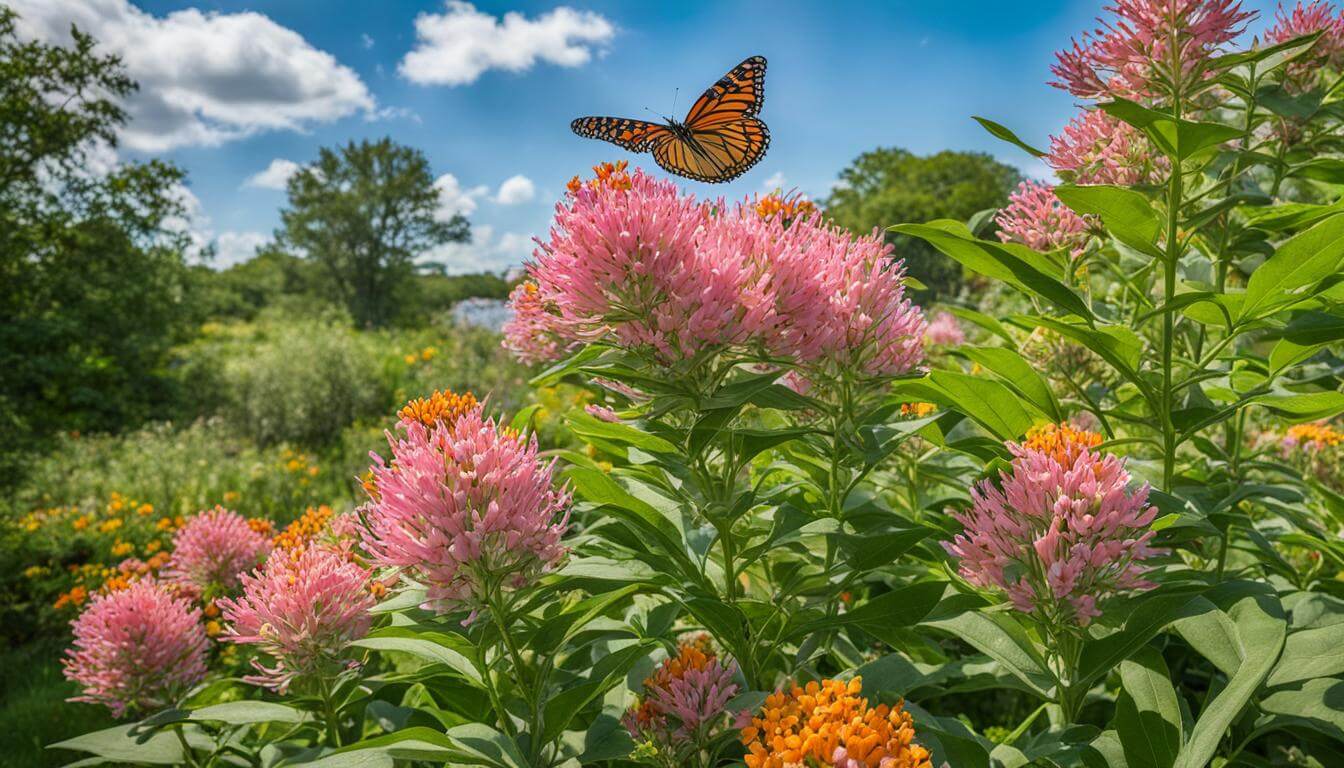
Watering and Mulching Practices for Milkweed Asclepias
Our endeavors to sustain monarch butterfly populations are deeply entwined with the care we offer to milkweed Asclepias, essential plants in these insects' lifecycle. A significant aspect of this care encompasses effective watering milkweed methods and mulching practices, which together ensure the viability and health of these plants through varying seasons.
Watering milkweed is a nuanced task that demands attentiveness to the amount of moisture the plants receive. These native perennials thrive when watered deeply yet infrequently, with the soil drying out somewhat between sessions. Establishing a regulated watering schedule that adapts to local climate conditions and seasonal rainfall patterns is crucial.
- Keep the soil consistently moist during seedling to encourage strong root development.
- Once established, reduce watering frequency to encourage deep root growth that supports the plants during dry spells.
- In heavy clay soils, less water is often required, as these tend to retain moisture longer than sandy soils.
Alongside a wise watering regimen, mulching practices are pivotal in milkweed plant health. Mulch helps regulate soil temperature, retain moisture, and suppress weed growth, contributing to a thriving garden that entices monarchs.
| Mulch Type | Benefits |
|---|---|
| Organic Mulch (e.g., straw or bark) | Improves soil nutrients as it decomposes and encourages beneficial soil organisms |
| Inorganic Mulch (e.g., black plastic) | Effective at warming the soil, retaining moisture, and preventing weed growth |
In mulching milkweed, we recommend applying a 2 to 3-inch layer around the base of your plants, taking care not to pile it against the stems, which could encourage rot. The selection of mulch type—whether organic or inorganic—should align with your specific garden conditions and the needs of your milkweed plants.
Combine such meticulous care with our collective resolve to grow these crucial nectar sources, and we foster a landscape where the monarch butterfly can survive and flourish.
Dealing with Pests and Diseases in Milkweed Cultivation
As we tend to our gardens to support monarch butterflies, we must also remain vigilant against the milkweed pests and milkweed diseases that can compromise the health of our common milkweed plants. Addressing these challenges proactively and responsibly is key to ensuring a robust milkweed Asclepias environment.
Recognizing and Treating Common Milkweed Afflictions
Early detection of issues is a cornerstone in managing afflictions in milkweed. Milkweed pests, such as aphids, spider mites, and milkweed bugs, can be identified by the visible presence on the stems and undersides of leaves or by the damage they inflict, like distorted growth or discolored foliage. Milkweed diseases, such as powdery mildew and rust, reveal themselves through unmistakable signs on the plant's surfaces.
- Aphids are treated with a strong water spray to dislodge or introduce beneficial insects like ladybugs.
- Spider Mites: Controlled by maintaining moisture levels as they thrive in dry conditions and using neem oil as a deterrent.
- Milkweed Bugs: Usually harmless but can be manually removed if in excess.
Milkweed diseases generally appear due to poor air circulation or overly damp conditions. Implementing proper plant spacing and pruning techniques are effective preventive measures.
| Affliction | Identification | Treatment |
|---|---|---|
| Powdery Mildew | The white, powdery coating on leaves | Improved air circulation, milkweed-safe fungicides |
| Rust | Orange or yellow spots on leaves | Removing affected leaves, fungicides if necessary |
Preventing Pests Without Harming Monarch Butterflies
In our commitment to nurture not just milkweed but the entire ecosystem it supports, it is critical to prevent pests in a way that does not harm the delicate monarch butterflies. Using chemical pesticides is not an option in our monarch-friendly gardens—instead, we seek organic and gentle solutions.
- Encouraging natural predators, such as birds and beneficial insects, by creating a diverse garden ecosystem.
- Use organic deterrents like neem oil or insecticidal soap sprays, which are effective yet mild.
- Maintaining garden hygiene by removing dead plant material that could harbor pests or diseases.
We actively check our plants and act quickly at the first signs of trouble, always prioritizing the safety and well-being of the entire garden community. The preservation and vitality of our milkweed stands are as much about consistent care as it is about informed interventions when faced with pests and diseases.
By embracing these strategies, we ensure that our milkweed plants remain robust and that the monarchs that depend on them are safe from harm. Together, we can overcome the challenges of milkweed pests and diseases, securing a future for these essential plants in our butterfly gardens.
Maintaining Your Milkweed Habitat for Monarchs
To foster a vibrant milkweed habitat, our seasonal care and cultivation practices are pivotal in creating a thriving ecosystem for monarch butterflies. By establishing and nurturing perennial milkweed plants, we lay the groundwork for a butterfly-friendly environment that supports cherished monarchs throughout their life cycle.
Seasonal Care for Perennial Milkweed Plants
Understanding the life cycle of perennial milkweed plants allows us to provide necessary seasonal care, ensuring our garden remains a compatible habitat for monarchs year after year. As the seasons change, so do the requirements of our milkweed stands. In spring, we prune back dead stalks for fresh growth. Summer demands consistent watering to moisten the soil, fostering lush blooms that attract butterflies.
- In the fall, we cut back foliage after the monarchs have migrated, cleaning up the garden and prepping plants for dormancy.
- Winter care often involves a protective layer of mulch to insulate the roots against extreme cold, fortifying the plants for the upcoming spring rebirth.
Occasionally, our milkweed clumps may need division to manage their spread and vigor, ensuring each plant has adequate space and resources to flourish. Typically undertaken in the spring or fall, this task invigorates the garden's overall health and vitality.
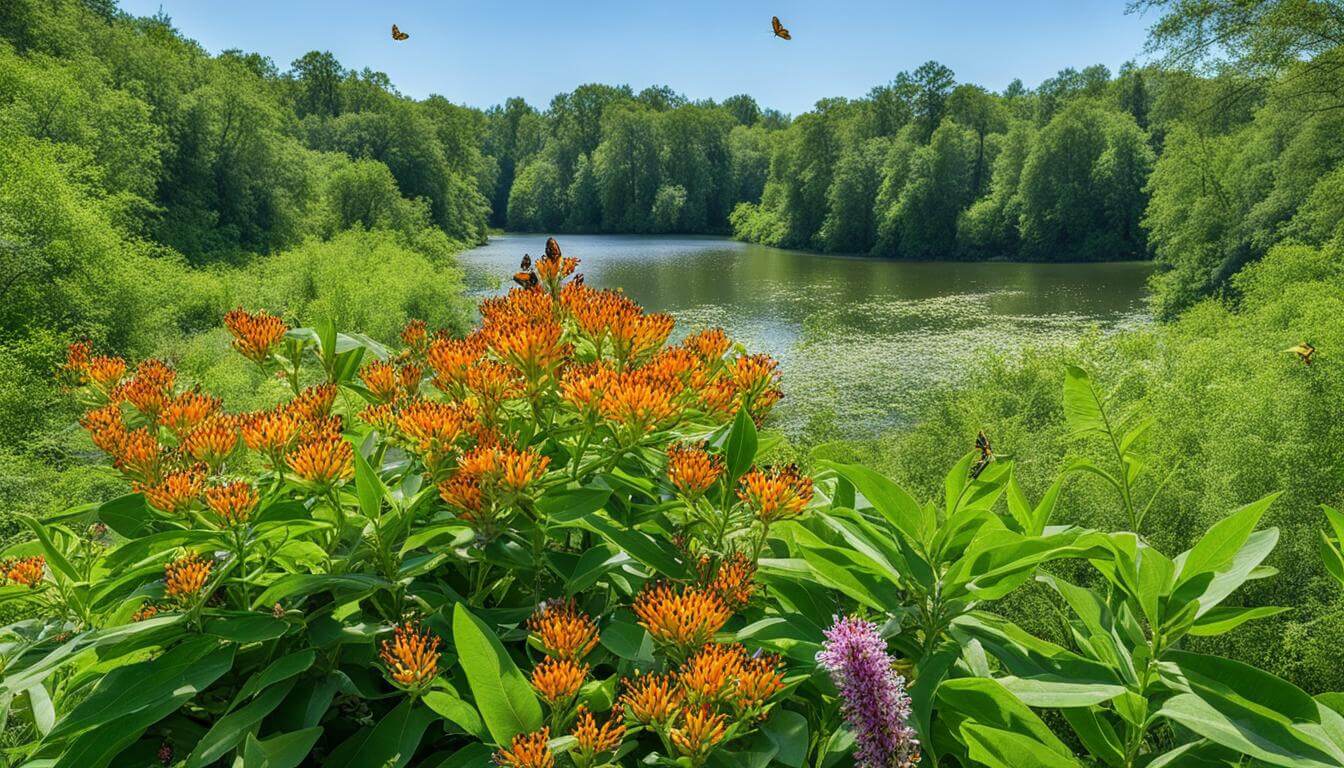
Creating a Butterfly-Friendly Environment with Milkweed
Encapsulating more than just the provision of milkweed, creating a butterfly-friendly environment in our gardens means embracing a holistic approach. We diversify plantings with a range of nectar-rich flowers to feed adult monarchs, providing sustenance from early spring through late fall.
- We choose companion plants that offer continuous blooms, such as Echinacea and Liatris, to ensure a steady supply of nectar.
- Pesticide-free gardening practices are vital to protect the delicate monarchs and other beneficial pollinators.
- Structures such as butterfly houses and moist soil patches for “puddling” cater to butterflies' unique behaviors and needs, enhancing their experience in our gardens.
We craft a micro-habitat that mirrors the larger ecosystem through intentional actions and dedicated care, inviting a symphony of pollinators alongside our esteemed monarchs. It's not just about growing plants; it's about cultivating life and supporting the intricate web of nature we are a part of.
Conclusion - How To Grow Showy Milkweed From Seed
As we reflect on our journey through the art of cultivating Asclepias speciosa, it becomes evident that our actions in our gardens ripple through the ecosystem. In fostering showy milkweed, we have embraced a powerful role in preserving monarch butterflies, ensuring these iconic pollinators thrive for generations. Let us summarize the crux of our collective gardening endeavors, illuminating the path we've carved out for these winged wonders.
Summary of Growing Showy Milkweed from Seed
We've ascertained that growing milkweed, particularly the illustrious showy milkweed, from seed, is no mere horticultural pursuit—it is an ecological commitment. We give these plants the best start by selecting the correct Asclepias speciosa seeds, executing pre-germination treatments, and planting them meticulously indoors. Yet, the continual tender care, deft management of watering, mulching, and overcoming pests and diseases crowns our efforts in success. Our gardens become veritable sanctuaries teeming with life as the robust milkweed we have nurtured stands tall, beckoning to the monarch butterflies.
Encouraging the Ecosystem: The Larger Impact of Your Garden
Indeed, the impact of these verdant expanses of showy milkweed transcends beyond our garden gates. By growing milkweed, we contribute to a grander vision, where biodiversity flourishes, and the tapestry of our local ecosystems is woven tighter and more resilient. The presence of monarch butterflies, flitting from bloom to bloom, becomes both a symbol and a measure of the vibrant health of our shared environment. In this manner, our humble patches of Asclepias speciosa radiate into a larger natural tableau, engendering a profound gardening impact that is a testament to our dedication and an emblem of hope for ecological harmony.
Wildflower, Perennial, & Annual Flower Seed Kit | 35 Variety Pack
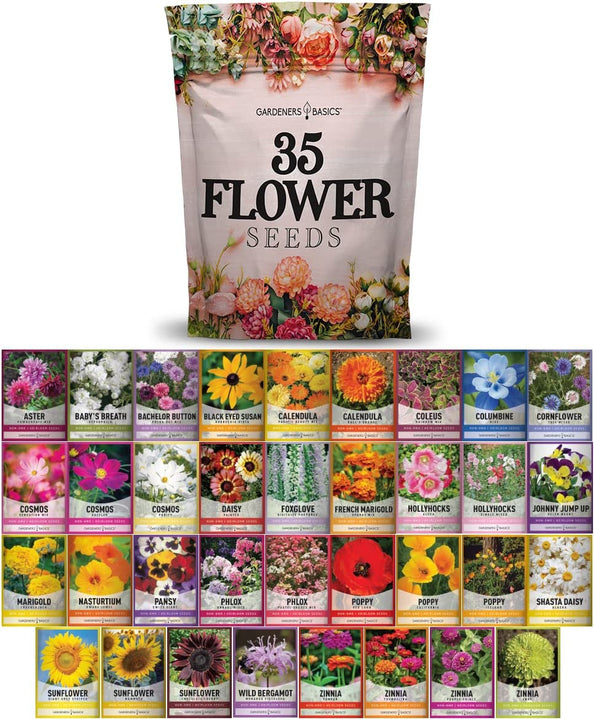
$29.95
$49.95
35 Flower Seeds Variety Pack – Heirloom, Non-Hybrid, Non-GMO, Open-Pollinated – Perfect for Pollinator-Friendly Gardens Transform your garden with our 35 Flower Seeds Variety Pack, offering a stunning and diverse selection of heirloom, non-hybrid, and non-GMO seeds. Each variety in… read more
FAQ - Snowy Milkweed Growing
How can I achieve a high germination rate for showy milkweed seeds?
To achieve a high germination rate for Asclepias speciosa, or showy milkweed, make sure to stratify the seeds by exposing them to cold temperatures for some time before planting, and you can also soak the seeds to soften the seed coat before planting them indoors.
Why is showy milkweed important for monarch butterflies?
Showy milkweed, Asclepias speciosa, is critical for the survival of monarch butterflies as it serves as the exclusive host plant for their larvae. The plants provide the nutrients for the larvae to develop and serve as a nectar source for adult monarchs.
What are the advantages of planting milkweed seeds indoors?
Planting milkweed seeds indoors gives you a head start on the growing season, allowing the plants more time to mature before being transplanted outdoors. This method ensures that the seedlings are strong and capable of thriving in full sun conditions, thus providing better support for monarch butterflies.
How should milkweed seeds be stratified?
Stratification of milkweed seeds involves simulating winter conditions by chilling the seeds in the refrigerator for several weeks. This process helps to break the seeds' dormancy and improve germination rates once planted.
What are the soil requirements for healthy milkweed growth?
Healthy milkweed growth requires well-draining and moderately fertile soil. Asclepias speciosa, or showy milkweed, prefers soil that is neither too wet nor too dry and can benefit from adding organic matter.
What are the best practices for watering and mulching showy milkweed?
Watering should be done to keep the soil moist but not waterlogged, and milkweed generally requires less frequent watering once established. Mulching helps conserve soil moisture, reduce weed competition, and regulate temperature.
How do you recognize and manage pests and diseases in milkweed plants?
To manage pests and diseases in milkweed plants, monitor your plants regularly for signs of trouble, like wilting, discoloration, or damage to the leaves. Identifying the problem accurately and applying appropriate organic or less harmful remedies to safeguard monarch butterflies is important.
What are the seasonal care requirements for perennial milkweed plants?
Seasonal care for perennial milkweed plants typically involves pruning back dead stems in the fall or early spring, spreading mulch for winter protection, and dividing clumps every few years to encourage vitality and prevent overcrowding.
How can I create a butterfly-friendly environment with milkweed in my garden?
Alongside growing milkweed, create a butterfly-friendly environment by planting various nectar-rich flowers, avoiding pesticides, and providing sheltered areas for butterflies to rest. Ensuring continuous blooms throughout the growing season will support a broader range of pollinators.
When is the best time to transplant milkweed seedlings outdoors?
Milkweed seedlings should be transplanted outdoors after the last frost when strong enough to withstand the elements. Typically, this is done after a period of hardening off, where seedlings are gradually exposed to outdoor conditions over a week or so.





